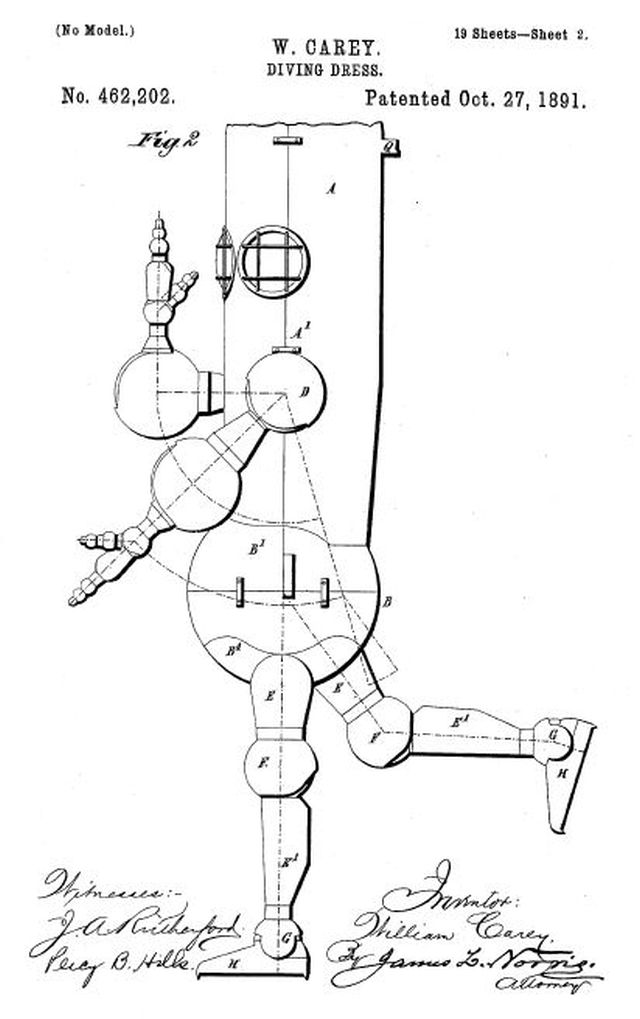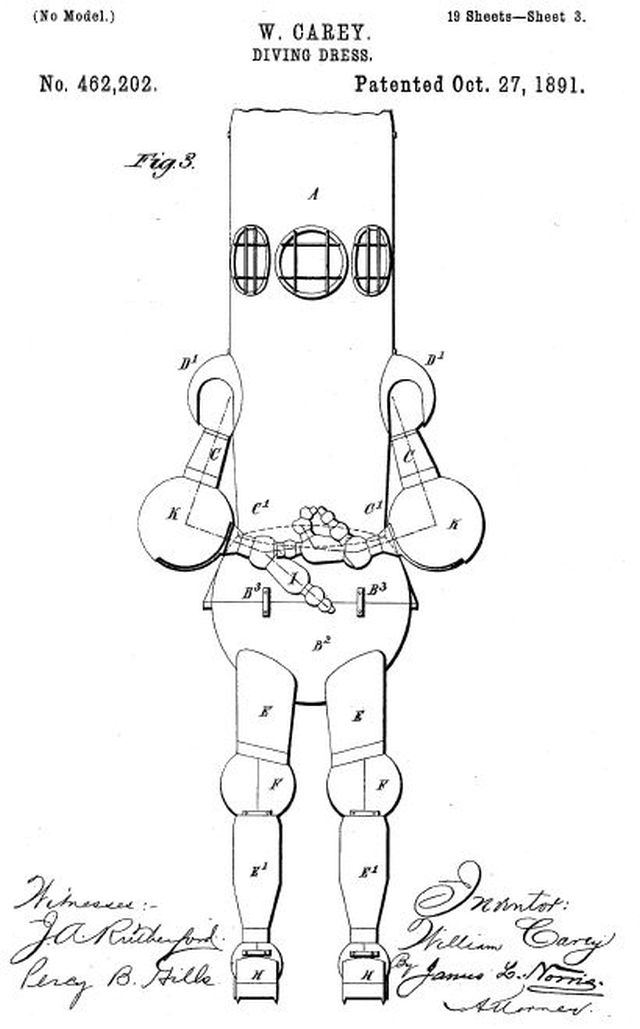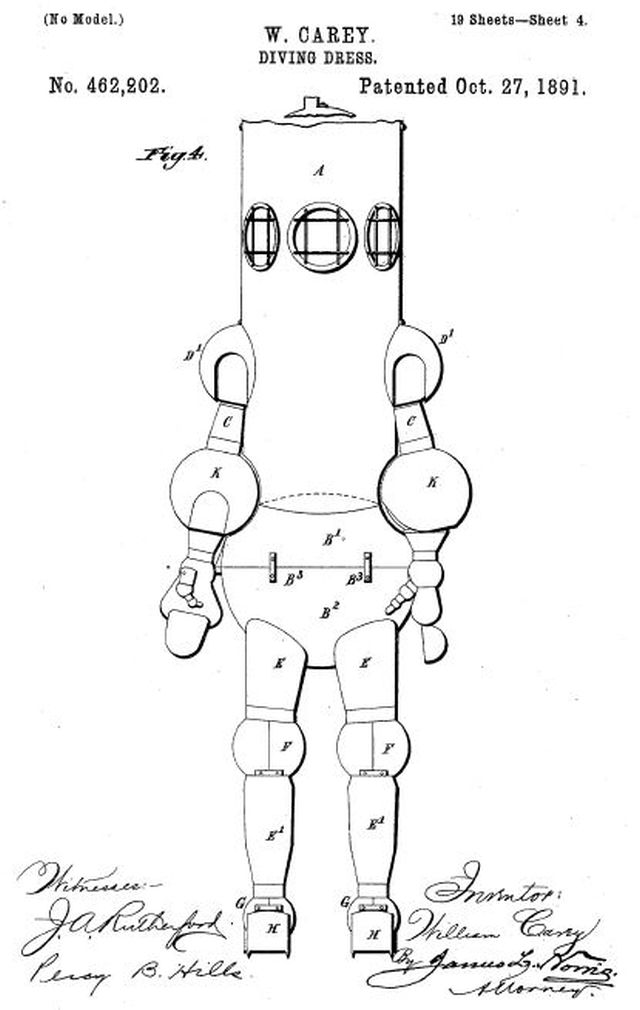1890 – Crustacean Diving Dress by Col. William Carey.
Source: English Mechanic and World of Science – Volume 53, 1891 – Page 351
Col. William Carey, C. B., late R.A., the “crustacean diving dress,” which he has protected by [Great Britain] patents 3083, 4467, and 6494 [6431?] of 1890, in which he shows how the lesson taught by nature, in the shape of the lobster and the crab, may be utilised for the construction of a diving dress for human beings superior to those at present in use.
The principle of its design being that "the lobster and crab in water do not carry their own shell." The particulars of this invention, a rather bizarre atmospheric diving suit made of metal, he had printed in a pamphlet, details from which are given in the article in the Star. William Carey was born in Guernsey in 1833, the son of Octavius Carey and Harriot Hirzel Le Marchant. He served in the Royal Artillery, and retired in 1891.
THE CRUSTACEAN DIVING DRESS.
THE fact that lobsters have been dredged up from depths exceeding 3,000 fathoms, suggested to Col. Carey, C.B., late R.A., the "crustacean diving dress," which he has protected by patents 3083, 4467, and 6431 of ISSO, which he shows how the lesson taught by nature, in the shape of the lobster and the crab, may be utilised for the construction of a diving dress.
Col. Carey contends that they must, first of all, be pressure resisting, so as to protect every part of a man's body from the weight of water surrounding him, amounting, roughly speaking, to about half a pound to the square inch for every foot in depth, to which he descends or desires to work in. The dress must be so constructed that the leg and arm casings must not only be flexible in all joints, but the dress itself and all its parts must be buoyant, carrying not only its own weight, but that of the diver as well, for it is manifest that if the limb casings are not buoyant and flexible, the diver will be unable to use his limbs, while if he is over-weighted with metal he will sink, and lie like a stone. Keeping these two broad principles in view. Col. Carey shows, by geometrical construction as well as by the most careful calculations, that such a design is feasible, and that its buoyancy — which means displacement in water — as well as its weight in metal, can be regulated to the 100,000th of a cubic inch, or less, and, having done so, contends that as a man, by reason of perfect buoyancy, would always be unsteady in water, he, the diver himself, must be the overweight to overcome that buoyancy, and by such an amount only as will enable him to ascend steady, and not be unsteady by the mere motion of his arms and hands when working. The amount of overweight can only be determined by practice, but, having arrived at this conclusion. Col. Carey saw that this is exactly the power exemplified in the crab and lobster to enable them to crawl and lie steadily at the bottom, and, watching them in an aquarium, it will be noticed that the crawling is by putting out one claw after another, for such movement does not overcome the extra weight enabling the fish to remain below; but, on one other hand, when all the claws are used together, the whole power of the fish is exerted and brought into play, for, although in lifting his flesh claw, the actual weight is taken off the bottom of the respective shell claws — which then rise by buoyancy, saving him the labour of raising the weight, — yet on his replacing the flesh claw, he replaces his weight and power, forcing the shell claw down against the resistance of the water, which then takes the small overweight of the fish and causes him to rise, while the drawing in of the front claws and shoving of the hind claws propels him through the water, and this causing him to swim ; and as the fish could not rise, as explained, if the overweight necessary to sink the shell exceeded that of the animal power, it is evident that nature regulates the growth and the construction of such fish, crustacea ??? ???, on that very principle demonstrating to man that if he attends to those points he will eventually succeed in so clothing himself, and obtain perfect mobility in water.
US Patent Publication number US462202 A
Publication date Oct 27, 1891
Filing date Oct 31, 1890
Inventor William Carey
Patented in England February 26, 1890,No. 3,083.
Be it known that I, WILLIAM CAREY, C. B., colonel Royal Artillery, a subject of the Queen of Great Britain, and a resident of Southampton, England, have invented certain new and useful Improvements in Diving Dresses.
My invention relates to diving-dresses, and is designed to improve the construction and increase the efficiency of the same.
Heretofore diving-dresses have usually been constructed in such a manner that when the diver is in the dress one or more additional weights are required to cause him to sink in the water. Moreover, such dresses have ordinarily been so made that the pressure of air within the diving-dress has had to be maintained equal to that of the water on the exterior of the dress. Consequently with the diving-dresses hitherto constructed the diver himself when working at great depths is subjected to very heavy pressure, the dress affording no protection to him in this respect, and the divers movements in the water are greatly impeded by his dress and by the additional weight or weights used for causing the dress with the diver therein to descend in the water.
My present invention is designed to facilitate the carrying out of submarine operations–that is to say, to enable divers to work with safety at greater depths and for longer periods than has hitherto been practicable, and to move in the water with greater ease and comfort than heretofore. For this purpose I construct my improved diving-dress on the same principles as those on which the shell-of the lobster or crab is formed. In other words, I so construct the diving dress that the weight thereof with the diver in it will be equal or approximately equal to the weight of the water displaced thereby. Therefore my improved diving-dress, though sufficiently buoyant to float by itself on the surface of the water, will when the diver is in the dress be caused by his weight, in addition to its own, to sink in the water, provided the diver-remains motionless. The diver can, however, by moving his limbs as required, rise in the water or travel through the same in any desired direction, the weight of the limb-casings being so proportioned that when either limb is raised by muscular action, the corresponding limb-casing will rise by its own buoyancy. Moreover, I so construct my improved diving-dress that it will withstand very high external pressure, thus obviating the necessity for introducing air under similar pressure into the dress. The pressure of the water is therefore borne not by the body of the diver, but entirely by the dress itself.
My diving-dress is made with peculiarly constructed spherical joints, whereby the separate parts of the dress are united in such a manner that the diver can freely use his limbs, and which are so constructed that the outer spheres of the said joints, which are formed in separate halves or parts, will be firmly closed and held together by the external pressure of the water, and very light clasps or fastenings of any convenient shape or form will serve for retaining them in place when the diver is out of the water. Each of these spherical joints is so constructed and arranged that its axis or center is coincident or approximately coincident with the joint of the divers body to which it corresponds.
Another feature of my said invention is the construction of the diving-dress in such a manner that the head-piece or helmet and the trunk or body portion extending to the stomach of the diver are or may be formed in a single piece, whereby a considerable increase in capacity is secured, and a storage of air is obtained sufficient to enable the diver to breathe for a considerable time in the event of injury to the air-tubes.
Another feature of my said invention is the arrangement of the inner spherical portion of the joint to work on pivots formed upon the interior of the outer spherical portion thereof, thus obviating the mechanical difficulties arising from the introduction of such pivots from the outside through a pivothole and the consequent liability to leakage and other defects.
Note: The Minsky-Bennett "Tentacle" arm, and "Senster", a work of robotic art created by Edward Ihnatowicz, were also inspired by lobster observation and natures' design.
See other early Underwater Robots here.





